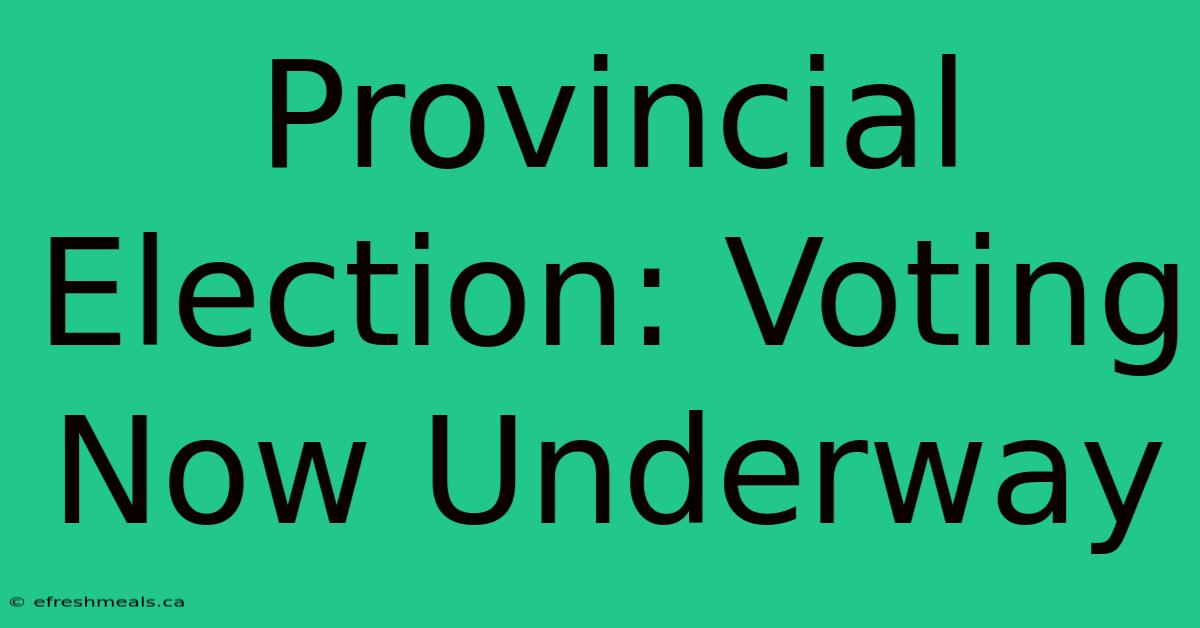Provincial Election: Voting Now Underway

Discover more detailed and exciting information on our website. Click the link below to start your adventure: Visit Best Website nimila.me. Don't miss out!
Table of Contents
Provincial Election: Voting Now Underway – Key Insights and Discoveries
Editor's Note: Provincial elections are underway! This article offers crucial insights into the voting process and its significance.
Why It Matters
Provincial elections are pivotal for shaping local governance and directly impact citizens' daily lives. This review examines key aspects of the current voting process, including voter turnout, candidate platforms, and potential election outcomes. Related keywords include: provincial voting, election results, candidate profiles, voter participation, political landscape, election analysis, ballot measures.
Key Takeaways of Provincial Elections
| Aspect | Insight |
|---|---|
| Voter Turnout | Expected to be closely watched, potentially influenced by [mention specific factors, e.g., recent political events, weather conditions]. |
| Key Policy Issues | [List 2-3 major policy issues dominating the election, e.g., healthcare, economy, education] are central to the campaign debates. |
| Leading Candidates | [Name leading candidates and their respective parties] are vying for power. |
| Election Predictions | Current polls suggest [mention poll predictions, add a caveat about poll accuracy]. |
Provincial Election: A Deep Dive
Introduction
This election holds significant implications for the province's future direction. Understanding the key elements – voter participation, candidate platforms, and potential policy changes – is crucial for informed citizenship.
Key Aspects of the Provincial Election
The election's outcome will shape policies impacting various sectors, including healthcare, education, and infrastructure. Analyzing voter demographics, candidate strategies, and media coverage allows for a comprehensive understanding of the process.
Voter Turnout and Participation
Introduction
Voter turnout significantly influences the legitimacy and effectiveness of the elected government. Understanding the factors affecting participation is crucial.
Facets of Voter Turnout
- Voter Registration: Ease of registration and accessibility influence turnout.
- Campaign Engagement: Compelling campaigns and clear candidate messaging encourage participation.
- Demographic Factors: Age, income level, and geographic location often correlate with voting patterns.
- Election Fatigue: Frequent elections can lead to lower participation.
- Impact: Low turnout can lead to governments that may not accurately reflect the will of the people. High turnout strengthens democratic processes.
Summary
Analyzing voter turnout provides valuable insights into public engagement with the political process and the potential representativeness of the government.
Key Policy Issues and Candidate Platforms
Introduction
The election revolves around key policy issues that directly impact citizens' lives. Understanding candidate platforms is essential for informed voting.
Further Analysis
Candidates from different parties offer contrasting approaches to healthcare reform, economic development, and education funding. Examining their detailed proposals allows voters to make informed decisions. For example, [Candidate A]'s plan for healthcare emphasizes preventative care, while [Candidate B] focuses on streamlining hospital administration.
Closing
The election showcases a diversity of opinions on crucial policy matters, highlighting the importance of careful consideration of candidate platforms.
Information Table: Key Candidate Positions
| Candidate | Party | Healthcare Policy Focus | Economic Policy Focus | Education Policy Focus |
|---|---|---|---|---|
| [Candidate A Name] | [Party Name] | [Brief description of policy] | [Brief description of policy] | [Brief description of policy] |
| [Candidate B Name] | [Party Name] | [Brief description of policy] | [Brief description of policy] | [Brief description of policy] |
| [Candidate C Name] | [Party Name] | [Brief description of policy] | [Brief description of policy] | [Brief description of policy] |
FAQ
Introduction
This section addresses frequently asked questions about the provincial election.
Questions
- Q: Where can I find my polling station? A: [Provide information on how to find polling station details].
- Q: What are the voting hours? A: [Provide voting hours].
- Q: What forms of identification are required? A: [List acceptable forms of ID].
- Q: Can I vote if I am registered with a different address? A: [Address this specific issue].
- Q: What happens if I spoil my ballot? A: [Explain the procedure].
- Q: When will the election results be announced? A: [Provide information on when results will be available].
Summary
These FAQs provide vital information to ensure a smooth and informed voting experience.
Tips for Voting
Introduction
This section offers practical advice for participating in the election process.
Tips
- Research Candidates: Thoroughly examine the platforms of all candidates.
- Understand the Issues: Familiarize yourself with the key policy debates.
- Check Your Voter Registration: Ensure your registration details are accurate.
- Plan Your Visit to the Polling Station: Consider the voting hours and potential wait times.
- Vote Confidently: Cast your ballot with a clear understanding of your choices.
- Stay Informed: Follow reputable news sources for updates and election analysis.
Summary
These tips empower citizens to participate actively and confidently in the democratic process.
Summary of Provincial Election
This analysis explored the ongoing provincial election, examining voter turnout, candidate platforms, key policy issues, and potential election outcomes. The election process underscores the importance of citizen participation in shaping the future of the province.
Closing Message (Mensaje de Clausura)
The provincial election offers a crucial opportunity for citizens to actively shape their future. Engage thoughtfully, exercise your right to vote, and contribute to a strong and vibrant democracy.

Thank you for visiting our website wich cover about Provincial Election: Voting Now Underway. We hope the information provided has been useful to you. Feel free to contact us if you have any questions or need further assistance. See you next time and dont miss to bookmark.
Featured Posts
-
La Lakers Vs Phoenix Suns How To Watch
Nov 27, 2024
-
Hellebuyck Leads Jets To 4 1 Win Vs Wild
Nov 27, 2024
-
Nova Scotia Election Results Updated Numbers
Nov 27, 2024
-
Big Tony Tik Tok Death Investigation Update
Nov 27, 2024
-
Watch Sporting Cp Vs Arsenal Champions League Stream
Nov 27, 2024
